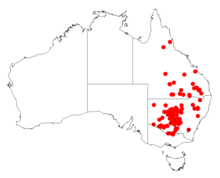Acacia homalophylla
Acacia homalophylla is a small tree found in the eastern half of Australia (where it is known as the yarran,[1] that has been introduced into India and Pakistan.[2]
| Acacia homalophylla | |
|---|---|
| Scientific classification | |
| Kingdom: | Plantae |
| Clade: | Tracheophytes |
| Clade: | Angiosperms |
| Clade: | Eudicots |
| Clade: | Rosids |
| Order: | Fabales |
| Family: | Fabaceae |
| Clade: | Mimosoideae |
| Genus: | Acacia |
| Species: | A. homalophylla |
| Binomial name | |
| Acacia homalophylla A. Cunn. ex Benth. | |
 | |
| Occurrence data from AVH | |
| Synonyms | |
| |
Etymology
The name probably refers to the smoothness of the phyllodes, which are flat and often appear veinless. Bentham, when publishing this species, used the spelling omalophylla, which he corrected to 'homalophylla' in his Flora of Australiense in 1864. The former spelling is used by some botanists and authors.[3]
Description
Acacia homalophylla has a clean trunk and leafy head, a dark gray, rough bark, narrow, usually straight leaves, and yellow flowers in balls. The leaves are edible and used for fodder.[4] It usually flowers in August–October, sometimes November.
It yields a gum.[5] Its wood (called myall-wood) is durable, fragrant, and dark-colored, and used by the natives for spears.[6]
References
- "Atlas of living Australia". Archived from the original on 21 December 2014.
- "International Legume Database".
- "Plantnet". Retrieved 20 December 2014.
- "Everist, 1969".
- Sturtevant's notes on edible plants. 1919. p. 19.
- Webster's Revised Unabridged Dictionary. 1913.